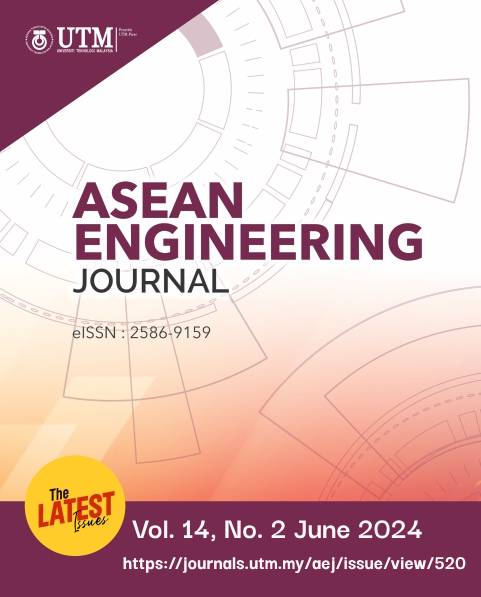THE EFFECT OF UTILIZATION OF AMBON BANANA PEEL POWDER ON PLASTIC VISCOSITY, YIELD POINT AND GELL STRENGHT OF FRESHWATER DRILLING MUD AT VARIOUS TEMPERATURES HWATER DRILLING MUD AT VARIOUS TEMPERATURES DRILLING MUD AT VARIOUS TEMPERATURES
DOI:
https://doi.org/10.11113/aej.v14.20027Keywords:
Drilling Fluid, Plastic Viscosity, Yield Point, Gell Strenght, Temperature, Ambon Banana Peel PowderAbstract
Drilling is part of exploration activities, where this activity aims to prove whether the zone exists or not. In the drilling process, drilling mud is needed to expedite the process, and the content contained in the drilling fluid consists of various additives. In this study, the ambon banana peel powder additive was tested to utilize household waste and minimize environmental impacts due to additives from raw materials. The use of banana peel powder in this study started with concentrations of 2 grams, 4 grams, 6 grams, and 8 grams, and seeing the concentration with the most optimal ability. Banana peel powder was used as a substitute for polymer in the mud system, which aims to maintain the rheology of the mud. Drilling, in this study, the parameter that is seen is the Plastic Viscosity, Yield Point and Gell Strength, where there is a change in the Plastic Viscosity, Yield Point and Gell Strength value from each addition of the concentration of Ambon banana peel powder. Temperature is also used to compare and see the effect of mud viscosity on temperature changes, the temperature used in this study is room temperature, which is 80°F, and the temperature at the roller oven is 200°F, where each temperature has a different value.
References
United Nations Environment Programme, 2005. “Solid Waste Management.” Accessed: Feb. 20, 2023. [Online]. Available: https://www.unep.org/explore-topics/resource-efficiency/what-we-do/cities/solid-waste-management
EPA, 2019 “Guide to the Facts and Figures Report about Materials, Waste and Recycling.” Accessed: Feb. 20, 2023. [Online]. Available: https://www.epa.gov/facts-and-figures-about-materials-waste-and-recycling/guide-facts-and-figures-report-about
John Hopkins University, 2006. “Municipal, Industrial, and Hazardous Waste.” Accessed: Mar. 16, 2019. [Online]. Available: http://ocw.jhsph.edu/ courses/EnvironmentalHealth/PDFs/Lecture15.pdf
A. T. Al-Hameedi, H. H. Alkinani, S. Dunn-Norman, H. W. Albazzaz, and M. M. Alkhamis, 2019 “Insights into Eco-Friendly and Conventional Drilling Additives: Applications, Cost Analysis, Health, Safety, and Environmental Considerations,” in Day 2 Wed, April 24, 2019, SPE. doi: 10.2118/195398-MS.
T. Al-Hameedi et al., 2019 “Evaluation of Environmentally Friendly Drilling Fluid Additives in Water-Based Drilling Mud,” in Day 2 Tue, June 04, 2019, SPE, Jun.. doi: 10.2118/195510-MS.
T. T. Al-Hameedi et al., 2020. “Laboratory Study of Environmentally Friendly Drilling Fluid Additives Banana Peel Powder for Modifying the Drilling Fluid Characteristics in Water-Based Muds,” in Day 2 Tue, January 14, 2020, IPTC, Jan. doi: 10.2523/IPTC-19964-MS.
T. Al-Hameedi et al., 2019. “Environmental Friendly Drilling Fluid Additives: Can Food Waste Products be Used as Thinners and Fluid Loss Control Agents for Drilling Fluid?,” in Day 2 Wed, April 24, 2019, SPE, Apr. doi: 10.2118/195410-MS.
T. T. Al-Hameedi et al., 2020, “Experimental investigation of environmentally friendly drilling fluid additives (mandarin peels powder) to substitute the conventional chemicals used in water-based drilling fluid,” Journal of Petroleum Exploration and Production Technology 10(2): 407–417. doi: 10.1007/s13202-019-0725-7.
T. T. Al-Hameedi et al., 2020 “Experimental investigation of bio-enhancer drilling fluid additive: Can palm tree leaves be utilized as a supportive eco-friendly additive in water-based drilling fluid system?” Journal of Petroleum Exploration and Production Technology, 10(2): 595–603, doi: 10.1007/s13202-019-00766-7.
Satiyawira, 2019 “Pengaruh Temperatur Terhadap Sifat Fisik Sistem Low Solid Mud Dengan Penambahan Aditif Biopolimer Dan Bentonite Extender,” PETRO:Jurnal Ilmiah Teknik Perminyakan, 7(4): 144–151, , doi: 10.25105/petro.v7i4.4282.
Satiyawira et al., 2020 “Laboratory study of the effect of various temperatures on the physical properties of low solid mud systems with addition of biopolymer and bentonite extender,”, 070032. doi: 10.1063/5.0012112.
W. F. Prassl, 2014 “Drilling Engineering,” in Dictionary Geotechnical Engineering/Wörterbuch GeoTechnik, Berlin, Heidelberg: Springer Berlin Heidelberg, 424–424. doi: 10.1007/978-3-642-41714-6_43985.
M. E. Hossain, 2016. Fundamentals of Drilling Engineering. Hoboken, NJ, USA: John Wiley & Sons, Inc., doi: 10.1002/9781119083931.
Baker Hughes, 1995. “Drilling Engineering Workbook A Distributed Learning Course,”
Rudi Rubiandini, 2010. Teknik Pemboran I. Institut Teknologi Bandung
Amoco Production Company, 1994. “Drilling Fluids Manual Section 1 Introduction Drilling Fluid Classifications,” Publisher?
Onwukwe and M. S. Nwakaudu, 2012, “Drilling Wastes Generation and Management Approach,” International Journal of Environmental Science and Development, 252–257, doi: 10.7763/IJESD. 2012.V3.226.
Borah and B. M. Das, 2022, “A review on applications of bio-products employed in drilling fluids to minimize environmental footprint,” Environmental Challenges, 6: 100411, doi: 10.1016/j.envc.2021.100411.
M. E. Hossain and M. Wajheeuddin, 2016, “The use of grass as an environmentally friendly additive in water-based drilling fluids,” Petroleum Science, 13(2): 292–303. doi: 10.1007/s12182-016-0083-8.
M. Edelstein, 2007 “Drilling Fluid Classification. Research in Social Problems and Public Policy,” in Cultures of Contamination - Legacies of Pollution in Russia and the U.S., 13–17. Elsevier. doi: 10.1016/S0196-1152(06)14023-5.
Borah and B. M. Das, 2022, “A review on applications of bio-products employed in drilling fluids to minimize environmental footprint,” Environmental Challenges. 6: 100411. doi: 10.1016/j.envc.2021.100411
















